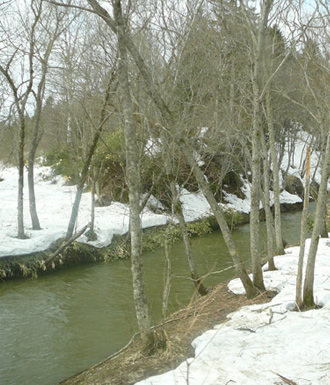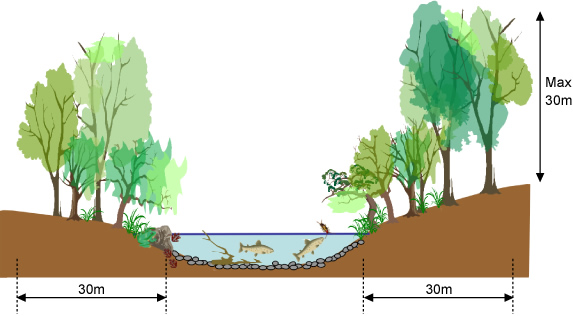The existing sound riparian forests are one of the reasons why Itou (sea-run taimen) remain in the Sarufutsu River. Then what roles do those riparian forests have?
Providing food : The riparian area with forests sees both aquatic and terrestrial ecosystems closely influence each other, which enhances biodiversity. Specifically, aquatic insects rely on leaves falling from riparian trees into the river as food and small fish catch these insects. Then sea-run taimen, standing at the top of the food chain, eat the small fish. Taimen also prey on terrestrial insects falling from riparian trees into the river and juveniles live on aquatic insects.
Block sunlight : Salmonids including sea-run taimen are cold water fish. Overhanging branches of riparian trees create shade over the river and protect taimen from the rising water temperature caused by the direct mid-summer sunlight.

Provide fallen trees and driftwood : When a big fallen tree or driftwood obstructs the water flow, it creates a large pool on its downstream side, providing juveniles with a place to hide or to overwinter.
Purify water quality : Riparian trees block the sediment outflow and protect gravel in the river bed that are the important spawning places for sea-run taimen. Without riparian forests, sediments accumulate on the river bed, making it impossible for taimen to spawn.

- Blocking sunlight –– They create shade and control a rise in water temperature as well as providing fallen leaves that serve as food for aquatic living organisms.
- Supplying organic matter –– Terrestrial insects fall into the river and serve as food for fish.
- Providing fallen trees and driftwood –– Formation of pools and hiding places.
- Purifying water quality –– Prevention of sediments from flowing into the spawning places.
- Habitat for aquatic and terrestrial organisms –– Enhanced wildlife biodiversity.
In the Sarufutsu River basin, Oji Paper Co., Ltd. has established the “Environmental Conservation Area” within its company forest that expands vastly over the river basin. The company is committed to conserve riparian forests within a streamside buffer zone: Thirty meters from the river’s edge on both sides through the Sarufutsu wilderness and most tributaries in its upper to middle reaches because riparian trees there can maximally grow up to 30 meters. Therefore, the company will cut no trees within the conservation area in principle. This ensures that almost all the riparian forests in the Sarufutsu River basin will be conserved for many years to come.
